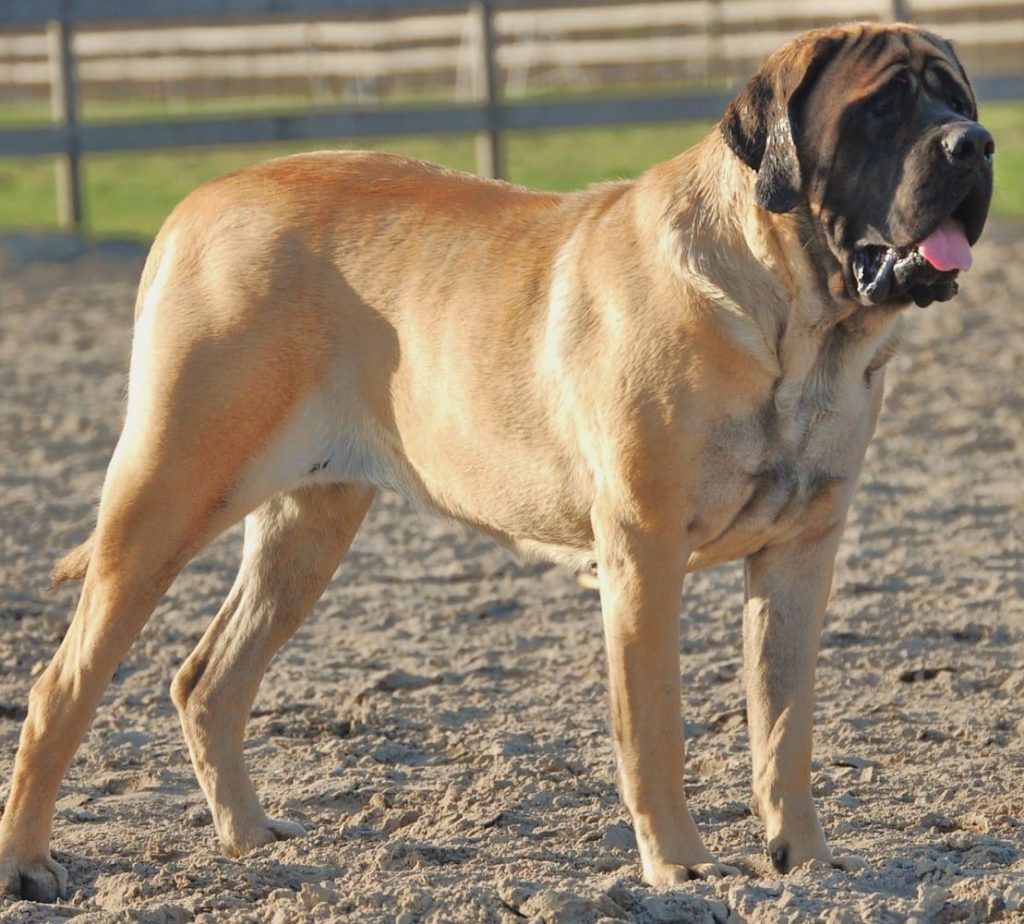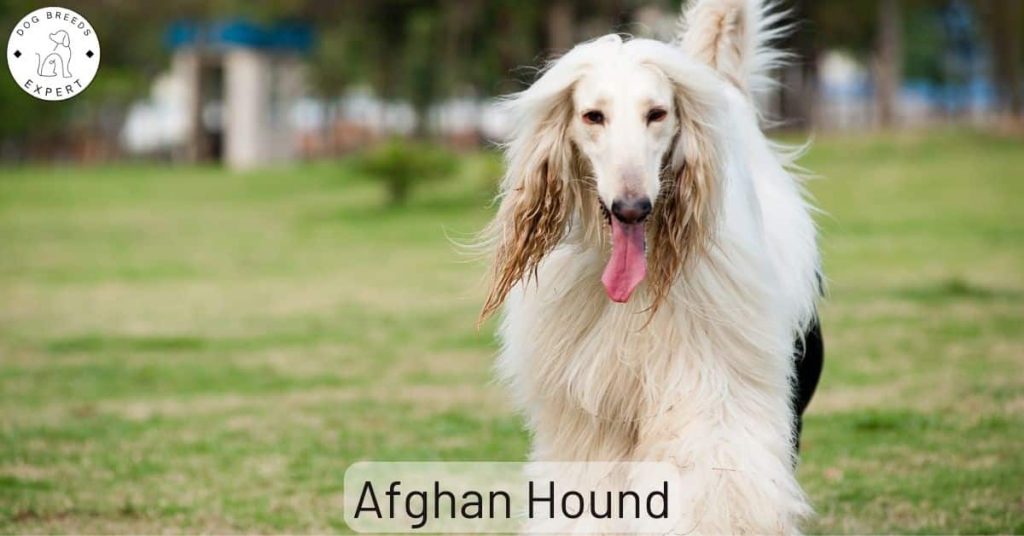The Mastiff dog is a big powerful protector and guard
The Mastiff breed of dog is sometimes confused with other breeds that have the word “mastiff” in their name. For example the Bullmastiff or the Neapolitan Mastiff. But in fact the Mastiff dog is a distinct breed all of its own. Sometimes referred to as the “English Mastiff”, the official kennel clubs in America and the U.K. simply refer to the breed as the “Mastiff”. They are BIG, weighing up to 230lbs and standing 30 inches and more at the withers. (shoulder).

The Mastiff Dog –
Temperament
The Mastiff is confident, calm and docile. Their amiable nature makes them very tolerant of children, taking their pranks and play-fights without blinking. This breed is not aggressive, and if they become annoyed at a small dog nipping at their heels, they will simply knock it over with a paw, and then wander off. They will not attack.
Mastiffs are intelligent and willing to please their owners. They become very protective of their ‘family’, and have a natural aloofness with people they do not know. They need space, both to wander around in, and also to stretch out and sleep – you need a big dog bed! For this reason, they are not best suited to apartment living, and do better in a suburban or rural setting.
They tend to snore when sleeping, and also slobber a bit after eating or drinking, but not excessively; a quick wipe with a cloth will do the trick. However, if you don’t like dog slobber, this may not be the breed for you.
Mastiff Dog – Breed History
The history of this breed is ancient and therefore clouded in speculation and legend; it is true that mastiff-like dogs have been around for thousands of years, particularly throughout Asia.
A British mastiff was certainly around when Caesar invaded the British Isles, as they were used by the defenders, and Caesar was impressed by these dogs, sending a number back to Rome. The British type of mastiff continued to evolve within the U.K., and became the English Mastiff that we would recognize today in the Middle Ages, around 1400 to 1600.
From the 19th century to the start of World War 1, Mastiffs were used as guard dogs for country estates and town businesses. From the 1880’s onwards, the modern Mastiff began to appear as an identifiable breed.
Ironically, after World War 2, there were very few Mastiffs left in England, and dogs from North America (mainly Canada) were imported into the U.K.. All Mastiffs bred in the U.K. from the 1950s onwards are from this North American stock.
There is some debate about the size of dog breeds, and which is the biggest breed. While the Irish Wolfhound and the Great Dane may be taller at the withers by up to 6 inches, they are not nearly as massive as the Mastiff in weight.

Vital Statistics;
Height; 30 inches + (males); 27.5 inches + (female).
Weight; 160lbs to 230lbs (male); 120lbs to 170lbs (females).
Life Span; 7 to 10 years.
Color;
Apricot, Brindle or Fawn, but always with a Black mask.
Ease of Training
This huge dog breed is generally not difficult to train; they are calm and amiable, and willing to please their owner. However, they sometimes lose interest in training and appear to have become deaf. Patience and a consistent approach is needed.
It is important to bear in mind that your sweet Mastiff puppy is likely to end up weighing more than you – so it is very important to train the dog while you are still able to impose yourself!
It’s best to start with early socialization, introducing your puppy to new sights, sounds, smells, and also strange people and strange animals, day by day. The next step is puppy training, for the basics of obedience. You must be fair but firm, and consistent with your commands. Do not accept a half-hearted response, nor having to repeat a command 3 times; otherwise the dog is learning to wait for the 3rd command before complying.
And discipline for bad behavior is also important. Before the dog grows too big, it must learn that you are in control. But the discipline must be at the instant of the unwanted behavior. If you discipline the dog a few minutes later, he will not understand.
We have a review page on this website on the 7 best dog training books – I recommend you take a look by clicking HERE!
Protection
For someone unfamiliar with the Mastiff, the first encounter may be a bit scary. This dog is built like a tank, and will stare down almost all unwelcome guests. This breed may not be quite the tallest, but is massive and looks very intimidating.
The intimidating appearance is just for starters. Bred for thousands of years to act as a guard dog for livestock and for humans, their guarding and protecting instinct is very strong. The breed is innately suspicious of strangers. If “the stare” does not put a stranger off, then the normally-silent Mastiff will bark, very loudly and deeply.
If the unwanted intruder then tries to go where he shouldn’t, the Mastiff is then very likely to knock them down. This dog is heavier than most men, and can keep a man on the floor for as long as it takes the owner to appear. The dog will not actually attack the intruder, but will subdue him very effectively.
If you are looking for protection, this dog breed will serve you well.

Grooming
The Mastiff Dog has a short, easily-groomed coat, according to the AKC.
They only need brief brushing every 2 to 3 days, unless they are shedding, when they will need a deeper groom with a strong-toothed comb to remove dead hairs.
The ears and deep wrinkles around the face should be cleaned and checked weekly to prevent infection or a build-up of grime.
The teeth should be brushed every day, using a dog-specific toothpaste, NOT a human toothpaste as it contains Xylitol. The claws should be checked each month, and trimmed if getting long to prevent cracking and splitting.
Health Considerations
This breed can grow quickly as a puppy, sometimes increasing in weight by 4 to 5 pounds in a week. But the skeleton does not mature until around 2 years of age, so it’s important to limit running, especially up and down stairs, until after that age.
However, they DO need regular exercise to stay healthy, and short walks 2 to 3 times a day is recommended. This keeps the dog used to exercise, and helps prevent it turning into a couch potato.
Due to their weight, they do need a cushioned, soft surface to sleep on.
Like other big breeds, they may be prone to gastric bloat. The best ways to prevent this are by feeding the dog in 2 to 3 smaller meals rather than one big meal, and also by using an anti-gulping bowl to slow down the speed of eating.

Fun Feeder Go Slow Anti-Gulping Dog Bowl
- Encourages eating and drinking at a slower pace
- Dishwasher safe
- Encourages pet to eat or drink at a slower pace preventing indigestion, vomiting and bloating
- Suitable for wet or dry food; Great solution for dogs who eat and drink quickly
Famous Mastiff dogs
The Mastiff dog breed features in numerous films, such as
- Marmaduke
- The Sandlot
- Hotel for Dogs
- Transformers
And they also feature in several books and other works of fiction.



